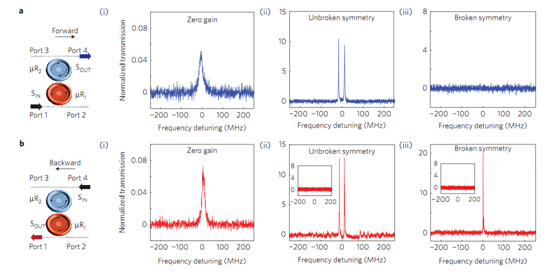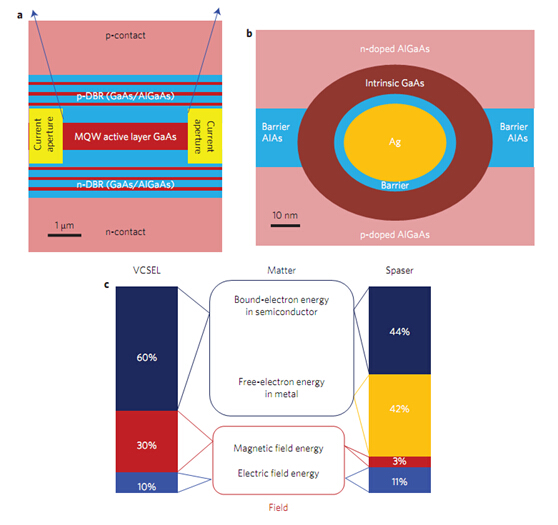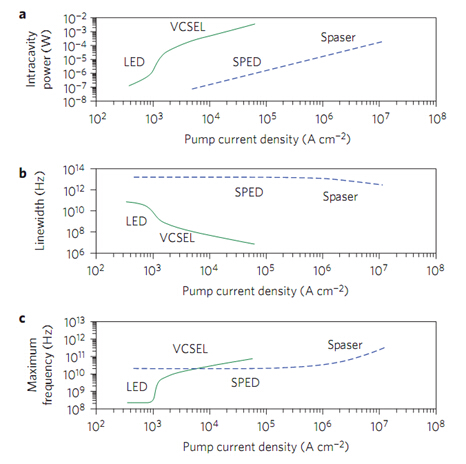一、本期重点:
Doi: 10.1038/NPHYS2927
Published: 2014.04
内容介绍:
增益损耗平衡的光学系统是一个很好的平台,是经典系统中对不具有厄米性但具有宇称时间对称哈密顿量的量子系统的一个很好的类比。本文中报导了在一种具有宇称时间对称的结构——耦合回音壁微腔,分析了这种结构从宇称时间对称到对称破缺的相变过程,并在宇称时间破缺相下观察到了光的非互易性传播。这种非互易性来源于强局域场带来的非线性效应的极大增强。而在线性下,无论宇称时间对称破缺与否,都观察不到非互易性。在实验中,由于谐振腔的作用,在一个传播方向上观察到了增强的谐振峰,而反方向传播的光没有谐振峰,实现光的单向导通。本实验结构对在集成光学系统上实现对光的片上操作及光传播方向的控制都起到了很大的促进作用。

图1)a.光从1端口输入,4端口输出;b.光从4端口输入,1端口输出。(i)、(ii)、(iii)分别是没有增益、对称未破缺、对称破缺下输出端口的情况。可看到,当处于宇称时间对称破缺情况下,端口4到端口1实现了单向导通。
.
2.表面等离子体激光器、垂直腔面发射激光器、表面等离子体发射二极管的比较和分析(Comparative analysis of spasers, vertical-cavitysurface-emitting lasers andsurface-plasmon-emitting diodes)[Nature Photonics]
Doi: 10.1038/NPHOTON.2014.94
Published: 2014. 06
内容介绍:
近年来,纳米光电子学器件及其集成技术发展迅猛。传统的纳米光电子学器件由于是介质材料,单个器件尺寸难以做到衍射极限以下。纳米等离子体器件因其可以大幅度缩减光电子原件的尺寸而得到广泛关注和研究,但大损耗是这类器件必须考虑和解决的问题。本文拿电泵浦亚波长等离子体激光器(Spaser)和已经普遍使用的全介质半导体激光器(VCSELs,垂直腔面发射激光器)做对比,从理论上分析指出,这两者在基础物理上比较类似,大部分的能量都集中在振荡的电子中而非电磁场中(前者是自由电子,后者是束缚电子)。但同时,由于金属的大损耗,两者的技术指标相差很大,Spaser比VCSEL至少阈值电流大3个数量级,线宽大4到5个数量级,而操作速率只是高几倍。这些理论结果可以作为研究者在设计光电子器件时的参考。

图2)a. VCSEL结构示意图,激光波长870nm;
b .电泵浦等离子体激光器结构示意图,激光波长同样是870nm
c.左边和右边分别是VCSEL和Spaser的能量分布图。

图3)a. VCSEL和Spaser输出光强度和泵浦电流关系,注意,Spaser没有阈值
b .VCSEL和Spaser线宽随泵浦电流关系
c. VCSEL和Spaser最大操作速率随泵浦电流的关系
二、简讯:
1.用于外泌小体分子检测和的性能分析的无需标记的纳米等离子体子传感器 (Label-free detection and molecular profiling of exosomes with a nano-plasmonic sensor)
Doi:10.1038/nbt.2886
Published:2014.05
Exosomes show potential for cancer diagnostics because they transport molecular contents of the cells from which they originate. Detection and molecular profiling of exosomes is technically challenging and often requires extensive sample purification and labeling. Here we describe a label-free, high-throughput approach for quantitative analysis of exosomes. Our nano-plasmonicexosome (nPLEX) assay is based on transmission surface plasmon resonance through periodic nanohole arrays. Each array is functionalized with antibodies to enable profiling of exosome surface proteins and proteins present in exosomelysates. We show that this approach offers improved sensitivity over previous methods,enables portable operation when integrated with miniaturized optics and allows retrieval of exosomes for further study. Using nPLEX to analyze ascites samples from ovarian cancer patients, we find that exosomes derived from ovarian cancer cells can be identified by their expression of CD24 and EpCAM, suggesting the potential of exosomes for diagnostics.
2.利用谐振金属天线和空间电导分布图样控制石墨烯等离子体子(Controlling graphene plasmons with resonant metal antennas and spatial conductivity patterns)
Doi: 10.1126/science.1253202
Published:2014.05.22
Abstract:
Grapheneplasmons promise unique possibilities for controlling light in nanoscale devices and for merging optics with electronics. We developed a versatile platform technology based on resonant optical antennas and conductivity patterns for launching and control of propagating grapheneplasmons, an essential step for the development of grapheneplasmonic circuits. We launched and focused infrared grapheneplasmons with geometrically tailored antennas and observed how they refracted when passing through a two-dimensional conductivity pattern, here a prism-shaped bilayer. To that end, we directly mapped the grapheneplasmonwavefronts by means of an imaging method that will be useful in testing future design concepts for nanoscalegrapheneplasmonic circuits and devices.
Doi:10.1103/PhysRevLett.112.213601
Published:2014.05.30
Abstrct:
New tools and approaches of quantum optics offer a unique opportunity to generate light pulses carrying a precise number of photons. Accurate control over the light pulses helps to improve the characterization of photoinduced processes. Here, we study interaction of a specialized light source which provides flashes containing just one photon, with retinal rod cells of Xenopuslaevis toads. We provide unambiguous proof of the single-photon sensitivity of rod cells without relying on the statistical modeling. We determine their quantum efficiencies without the use of any precalibrated detectors and obtain the value of (29±4.7)%. Our approach provides the path for future studies and applications of quantum properties of light in phototransduction, vision, and photosynthesis.
4.利用局域表面等离子共振芯片实现对血清中的癌症标记物并行、快速、高灵敏度的检测(LSPR Chip for Parallel, Rapid, and Sensitive Detection of Cancer Markers in Serum)
Doi:10.1021/nl500574n
Published:2014.04.14
Abstrcat:
Label-free biosensing based on metallic nanoparticles supporting localized surface plasmon resonances (LSPR) has recently received growing interest (Anker, J. N., et al. Nat. Mater. 2008, 7, 442–453). Besides its competitive sensitivity (Yonzon, C. R., et al. J. Am. Chem. Soc. 2004, 126, 12669–12676; Svendendahl, M., et al. Nano Lett. 2009, 9, 4428–4433) when compared to the surface plasmon resonance (SPR) approach based on extended metal films, LSPR biosensing features a high-end miniaturization potential and a significant reduction of the interrogation device bulkiness, positioning itself as a promising candidate for point-of-care diagnostic and field applications. Here, we present the first, paralleled LSPR lab-on-a-chip realization that goes well beyond the state-of-the-art, by uniting the latest advances in plasmonics, nanofabrication, microfluidics, and surface chemistry. Our system offers parallel, real-time inspection of 32 sensing sites distributed across 8 independent microfluidic channels with very high reproducibility/repeatability. This enables us to test various sensing strategies for the detection of biomolecules. In particular we demonstrate the fast detection of relevant cancer biomarkers (human alpha-feto-protein and prostate specific antigen) down to concentrations of 500 pg/mL in a complex matrix consisting of 50% human serum.
供稿人:徐颖鑫 王一霈 林星 陈必更 李志勇







